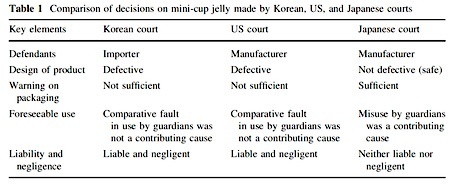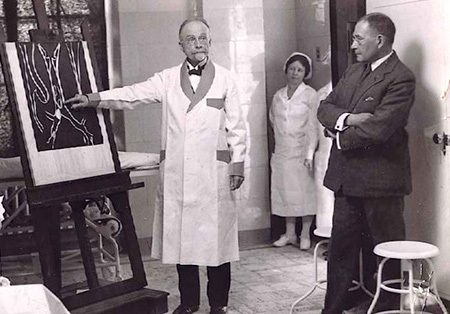Marc Abrahams's Blog, page 368
October 18, 2014
Lots of data and info about paper airplanes, and lots of planes
Lots of data and info about paper airplanes, from Papierfliegerei:
From flight tests and experiments, a lot can be gained qualitative statements about paper airplanes. Paper airplanes cost so much, because empiricism is certainly a possible solution. But you can also calculate pretty good paper airplane. The Excel table on the right is intended to provide a little insight you there. If you are interested, on which formulas are based the results of the table and how they are derived, can you in my book read.
use this Excel table, the simple paper airplane can be quite accurately. In the upper part of the table the necessary inputs for the calculation to be made.
The paper airplane enthusiast behind the site built, and in this video demonstrates, a machine for making and launching a fleet of paper airplanes:

October 17, 2014
3-D carving (rather than printing), for teeth
The 3-D printing revolution gets most of the attention, but 3-D carving has already added a very real bite to modern healthcare. Dentists (and engineers) are leading the way.
A considerable number of people are strolling the streets, smiling, chewing the fat, and eating lunch — sporting dental crowns made through a process of 3-D scanning and then 3-D milling. The video above shows one dentist proudly showing off his tooth-milling machine.
Why milling (carving slowly, in a process that is literally grinding), rather than printing? Because teeth need to be hard, if they are to survive years of chomping….
So begins another Improbable Innovation nugget, which appears in its entirety on BetaBoston.

The Rheology of Ant Swarms
Room 007 of the Love Building at Gatech, Atlanta, Georgia is the home of the Hoogle Lab. It’s run by David L. Hu (Assistant Professor of Fluid Mechanics) who is the corresponding author for the robotic jumping-beans study which Improbable recently profiled. But the Hoogle Lab doesn’t exclusively focus on jumping beans, it also investigates the ‘rheology’ of ants – in other words the study of how large groups of ants might be compared to fluids. Full details can be found here, including this video showing how ants can be ‘poured’ through a funnel.
For (a few) more details see : Ants as Fluids: Physics-Inspired Biology

October 16, 2014
Fashionable photos of the Ig Nobel ceremony
Of the many press reports about this year’s Ig Nobel Prize ceremony, perhaps the nicest photo spread was done by the magazine Paris Match.

The Mini-Cup Jelly Court Cases
 The mini-cup jelly court cases are no longer quite so far beneath the world’s “attention radar” awareness level. A new study dares to look at, and speak of, them:
The mini-cup jelly court cases are no longer quite so far beneath the world’s “attention radar” awareness level. A new study dares to look at, and speak of, them:
“The Mini-Cup Jelly Court Cases: A Comparative Analysis from a Food Ethics Perspective,” Suk Shin Kim, Journal of Agricultural and Environmental Ethics, October 2014, Volume 27, Issue 5, pp 735-748. (Thanks to investigator Tom Gill for bringing this to our attention.) The author, at the Department of Food Science and Nutrition, The Catholic University of Korea, explains:
“This study compares and analyzes separate court rulings in three countries on ‘mini-cup jelly’ (a firm jelly containing konjac and packaged in bite-sized plastic cups) from a food ethics perspective. While the Korean and US courts decided that the mini-cup jelly was defective, and that the manufacturers or importers were liable for damages in these cases, the Japanese court took an opposing stance in favor of the manufacturer. However, from an absolute and fundamental viewpoint, the jelly was unacceptable, ethically as well as legally, because it was unsafe, unwholesome, and unfit for children’s consumption. I argue that the ignoring or sidelining of fundamental principles of food ethics, especially “respect for life,” was at the core of these cases…. To conclude, it is very important to minimize risks by applying the principles of food ethics at the outset before any accidents can occur.”
Here’s further detail from the study:
A news headline ten years ago foreshadowed some of these developments: “EFSA risk opinion on jelly mini-cup additives could equate to full ban“

October 15, 2014
Ig Nobel winner triumphs: “Italy lifts out of recession thanks to hookers, drugs”
 Congratulations to this year’s Ig Nobel economics prize winner — ISAT — both on its Ig Nobel Prize and on ISTAT’s influence on the Italian economy.
Congratulations to this year’s Ig Nobel economics prize winner — ISAT — both on its Ig Nobel Prize and on ISTAT’s influence on the Italian economy.
The AFP news agency reports, on October 15, 2014:
Italy lifts out of recession thanks to hookers, drugsItaly learnt it was no longer in a recession on Wednesday thanks to a change in data calculations across the European Union which includes illegal economic activities such as prostitution and drugs in the GDP measure.
Adding illegal revenue from hookers, narcotics and black market cigarettes and alcohol to the eurozone’s third-biggest economy boosted gross domestic product figures.
GDP rose slightly from a 0.1 percent decline for the first quarter to a flat reading, the national institute of statistics said.
Although ISTAT confirmed a 0.2 percent decline for the second quarter, the revision of the first quarter data meant Italy had escaped its third recession in the last six years….
This comes just four weeks after this year’s Ig Nobel Prize winners were announced at the Ig Nobel Prize ceremony, at Harvard University. The 2014 Ig Nobel Prize for economics was awarded to ISTAT — the Italian government’s National Institute of Statistics, for proudly taking the lead in fulfilling the European Union mandate for each country to increase the official size of its national economy by including revenues from prostitution, illegal drug sales, smuggling, and all other unlawful financial transactions between willing participants.
The relevant documents, in the awarding of that prize, are “Cambia il Sistema europeo dei conti nazionali e regionali – Sec2010” (ISTAT, 2014) and “European System of National and Regional Accounts (ESA 2010)” (Luxembourg: Publications Office of the European Union, 2013).
BONUS: “Droghe e prostituzione nel Pil, all’Istat il premio IgNobel per l’Economia” [La Repubblica]

Jumping beans (the locomotion of)
The US-based Georgia Institute of Technology (Gatech) isn’t just known for undertaking research into lethal weapons systems – far from it – it also investigates, for example, the locomotion and ‘navigation’ abilities of Mexican Jumping Beans. The beans, which are inhabited by the larvae of the moth Laspeyresia saltitans (or sometimes Cydia deshaisiana) have an unusual way of getting from A to B.
“The locomotion of the Mexican jumping bean relies on rolling, which is rare in the natural world.” explain a Gatech research team in a 2012 paper – noting too that : “Few animals rely on wheels rather than appendages …” [see bonus question below]
Observations such as these provided the impetus for a combined experimental, numerical and robotic study which investigated the beans’ unique means of rolling locomotion and their possible applicability to biomimetic micro-scale navigation systems. See: ‘Locomotion of Mexican jumping beans’ in: Bioinspiration & Biomimetics, 7, 036014 (12pp)
Bonus Question : Which (non-cyborg) animals do rely on wheels rather than appendages?

October 14, 2014
mini-AIR (October issue): Monsters at the Royal Society, etc.
 The October issue of mini-AIR (our monthly e-mail newsletter just went out. (mini-AIR is a wee little supplement to the magazine). Topics include:
The October issue of mini-AIR (our monthly e-mail newsletter just went out. (mini-AIR is a wee little supplement to the magazine). Topics include:
Vampires and Rabies
Monsters at the Royal Society
Dam, Bloodsucking Blackflies Limerick Competition
and more
It also has info about upcoming events.
Mel [pictured here] says, “It’s swell.”
mini-AIR is the simplest way to keep informed about Improbable and Ig Nobel news and events.
Want to have mini-AIR e-mailed to you every month? Just add yourself to the mini-AIR list.
BONUS: Investigator Paul Tomblin, who reads mini-AIR, send us this note: “Not an entry [in the limerick contest], but no discussion of dams and bloodsucking blackflies is complete without a reference to Wade Hemsworth‘s Blackfly Song:

A complicated way to say: ‘Flip a coin’
Considerable expense and effort are thrown at the question: What will people choose?
Which cell phone? Which features? Which dinner entrée? Which school? Which local political candidate? Which stock or bond? Which financial advisor? Which job candidate? Which job? Which hole to stick your nose in, if you’re offered a choice?
BUT BUT BUT sometimes, maybe much of the time, people choose at random. (You can say that in a more impressively academic-sounding way: Sometimes people choose stochastically.)
A new study suggests that it’s not just a people thing, this choosing at random. Sometimes rats do it, too….
So begins another Improbable Innovation nugget, which appears in its entirety on BetaBoston.
Here’s detail from that study:

The swallowed objects amassed by Chevalier Jackson
The Mutter Museum has, among its protected treasures, one of Philadelphia’s largest collections of swallowed (and eventually retrieved, by medical personnel) objects. (Thanks to Paige Williams for bringing this to our attention.) The museum explains:
Chevalier Jackson CollectionChevalier Jackson, MD (1865-1958), was a renowned Philadelphia otolaryngologist and Fellow of The College of Physicians of Philadelphia. He developed methods and tools for removing foreign objects from human airways. The Jackson Collection includes 2,374 inhaled or swallowed foreign bodies that Dr. Jackson extracted from patients’ throats, esophaguses, and lungs during his almost 75-year-long career. Most of the items are on display….
The collector, the now-late Dr. Chevalier Jackson, is the same Chevalier Jackson three of whose works were celebrated in last month’s issue of mini-AIR.

Marc Abrahams's Blog
- Marc Abrahams's profile
- 14 followers







